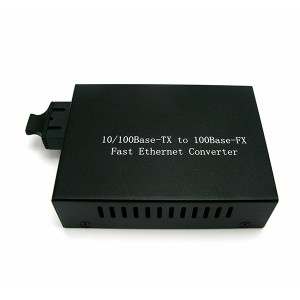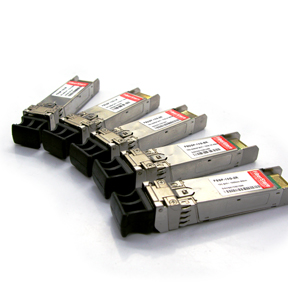What is an OTDR and How does it Work?
What is an OTDR?

OTDR, short for optical time-domain reflectometer, is an optoelectronic instrument used to characterize an optical fiber. It can be considered as the optical equivalent of an electronic time-domain reflectometer.
OTDR injects a series of optical pulses into the fiber under test. It also extracts, from the same end of the fiber,light that is scattered or reflected back from points along the fiber. The strength of the return pulses is measured and integrated as a function of time, and is plotted as a function of fiber length.
It may be used for estimating the fiber length and overall attenuation, including splice and mated-connector losses. It may also be used to locate faults, such as breaks, and to measure optical return loss. To measure the attenuation of multiple fibers, it is advisable to test from each end and then average the results, however this considerable extra work is contrary to the common claim that testing can be performed from only one end of the fiber.
In addition to required specialized optics and electronics, OTDRs have significant computing ability and a graphical display, so they may provide significant test automation. However, proper instrument operation and interpretation of an OTDR trace still requires special technical training and experience.
(Reference: FIBERSTORE OTDR Tutorial)
How Does an OTDR Work?
OTDR fiber tester works indirectly by using a unique phenomena of fiber to imply loss, unlike fiber optic light sources and power meters which measure the loss of the fiber optic cable plant directly by duplicating the transmitter and receiver of the fiber optic transmission links. It works like a radar. It first to send a signal for optical fiber, and then observe what return from one point to the information. This process will be repeated, then the results were averaged and to be displayed in the form of track, the track is described within the whole period of optical fiber (or the state) of the fiber on the strength of the signal.
As light travels along the fiber, a small proportion of it is lost by Rayleigh scattering. Rayleigh scattering is caused by the irregular scattering signal along the fiber produced. Given fiber optic transceiver parameters, the Rayleigh scattering power can be marked out. If the wavelength is known, it is proportional to the signal of pulse width, the longer backscattering, the stronger power. Rayleigh scattering power is related to the wavelength of emission signal, the shorter wavelength, the stronger power. That is to say, 1310nm signal path of the Rayleigh backscattering is higher than 1550 nm Rayleigh backscattering.
OTDR uses Rayleigh scattering to represent the characteristics of fiber optic. OTDR measurements back to part of scattering light to the OTDR port. As the light is scattered in all directions, some of it just happens to return back along the fiber towards the light source. This returned light is called backscatter as shown below.


The backscatter power is a fixed proportion of the incoming power and as the losses take their toll on the incoming power, the returned power also diminishes as shown in the figure.

OTDR uses the backscattered light to make its measurements. It sends out a very high power pulse and measures the light coming back. It can continuously measure the returned power level and hence deduce the losses encountered on the fiber.
Any additional losses such as connectors and fusion splices have the effect of suddenly reducing the transmitted power on the fiber and hence causing a corresponding change in backscatter power. The position and degree of the losses can be ascertained. At any point in time, the light the OTDR sees is the light scattered from the pulse passing through a region of the fiber.
Think of the OTDR pulse as being a virtual source that is testing all the fiber between itself and the OTDR as it moves down the fiber.Since it is possible to calibrate the speed of the pulse as it passes down the fiber, the OTDR can correlate what it sees in backscattered light with an actual location in the fiber. Thus it can create a display of the amount of backscattered light at any point in the fiber.
There are some calculations involved. Remember the light has to go out and come back, so you have to factor that into the time calculations, cutting the time in half and the loss calculations, since the light sees loss both ways. The power loss is a logarithmic function, so the power is measured in dB.
The amount of light scattered back to the OTDR is proportional to the backscatter of the fiber, peak power of the OTDR test pulse and the length of the pulse sent out. If you need more backscattered light to get good measurements, you can increase the pulse peak power or pulse width as shown in the picture.

Some events like connectors show a big pulse above the backscatter trace. That is a reflection from a connector, splice or the end of the fiber. They can be used to mark distances or even calculate the back reflection of connectors or splices, another parameter we want to test in single mode systems.
OTDRs are generally used for testing with a launch cable and may use a receive cable. The launch cable allows the OTDR to settle down after the test pulse is sent into the fiber and provides a reference connector for the first connector on the cable under test to determine its loss. A receive cable may be used on the far end to allow measurements of the connector on the end of the cable under test also.
FiberStore OTDRs are available with a variety of fiber types and wavelengths, including single mode fiber, multimode fiber, 1310nm, 1550nm, 1625nm, etc.. We also supply OTDRs of famous brands, such as JDSU MTS series, EXFO FTB series, YOKOGAWA AQ series and so on. OEM portable and handheld OTDRs (manufactured by FiberStore) are also available.Click for the OTDR price.
Small Form Factor Fiber Optic Connectors
Since the 1990s, many small form factor (SFF) fiber optic connectors have been developed to fill the interest in devices that may fit into tight spaces and permit denser packing of connections such as fiber patch cables. Some are miniaturized versions of older connectors, built around a 1.25mm ferrule rather than the 2.5mm ferrule used in ST, SC and FC connectors. Others are based on smaller versions of MT-type ferrule for multi fiber connections, or other brand new designs.
Most of these SFF connectors have a push-and-latch design that adapts easily to duplex connectors. LC, MU, E2000 and MT-RJ would be the most typical small form factor fiber optic connectors.
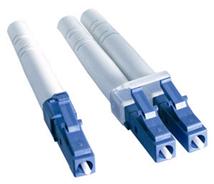 1. LC Connector
1. LC Connector
LC is short for Lucent Connector, licensed by Lucent. LC connector may also be called “Little Connector”. It resembles a typical RJ45 telephone jack externally, while a miniature version of the SC connector internally. LC connector uses a 1.25mm ceramic (zirconia) ferrule instead of the 2.5mm ferrule and add a push-and-latch design providing pull-proof stability in system rack mounts. LC connectors are highly favored for single mode applications such as high-density connections, SFP transceivers, XFP transceivers, etc.. Generally, LC connectors can be found in simplex and duplex, single mode and multimode versions.
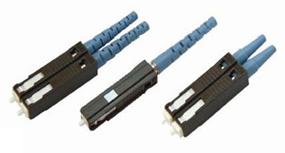 2. MU Connector
2. MU Connector
MU is brief for Miniature Unit, produced by NTT. MU connector is known as “mini SC” and is popular in Japan. It has push-pull mechanism, utilizing a 1.25mm ferrule the same as LC connector. MU connectors’ applications include high-speed data communications, voice networks, telecommunications, and dense wavelength division multiplexing (DWDM). They’re also utilized in multiple optical connections so that as a self-retentive mechanism in backplane applications. MU connectors can be found in simplex and duplex versions.
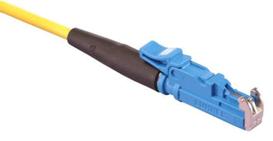 3. E2000 Connector
3. E2000 Connector
E2000, as known as laser shock hardening (LSH), is a technology generally used in Telecom, DWDM systems. E2000 connector is also called LX.5 connector. It looks like a miniature SC connector externally, like the MU connector utilizing a 1.25mm ferrule. You can easily install, with a snap-in and push-pull latching mechanism which clicks when fully inserted. E2000 connector includes a spring-loaded shutter which fully protects the ferrule from dust and scratches. The shutter closes automatically once the connector is disengaged, locking out impurities which could later result in network failure, and locking in possibly damaging lasers. When it’s connected to the adapter the shutter opens automatically. E2000 connectors are available in single mode and multimode versions. FiberStore provides both E2000 to ST fiber patch cable and fibre optic patch cables E2000 LC rich in quality and best price.
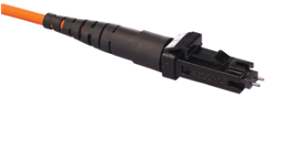 4. MT-RJ Connector
4. MT-RJ Connector
MT-RJ is short for Mechanical Transfer Registered Jack. MT-RJ connector’s overall dimensions are comparable like a RJ45 connector. MT-RJ connector dose not make use of a 1.25mm ferrule, and it is design is derived from MT ferrule. It features a miniature two-fiber ferrule with two guide pins parallel to the fibers on the outside. The guides pins align ferrules precisely when mating two MT-RJ connectors. MT-RJ connectors are designed with male-female polarity which means male MT-RJ connector has two guide pins and feminine MT-RJ connector has two holes instead. MT-RJ connectors are utilized in intra building communication systems. Since they are designed as plugs and jacks, like RJ-45 telephone connectors, adapters can be used with a few designs, but are not required for all. MT-RJ connectors are available in duplex version only and multimode version only given that they use the two-fiber ferrules.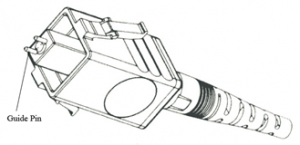
SFP Plus Direct Attach Copper Cables

What is SFP+ Direct Attach Copper Cable?
SFP+ direct attach copper cable, also known as Twinax Cable, is a SFP+ cable assembly used in rack connections between servers and switches. It consists of a high speed copper cable and two copper SFP+ modules. The Plus SFP module allow hardware manufactures to achieve high port density, configurability and utilization at a very low cost and reduced power budget.
Direct Attach Cable assemblies are a high speed, cost-effective alternative to fiber optic cables in 10Gb Ethernet, 8Gb Fibre Channel and InfiniBand applications. They are suitable for short distances, making them ideal for highly cost-effective networking connectivity within a rack and between adjacent racks. They enable hardware OEMs and data center operators to achieve high port density and configurability at a low cost and reduced power requirement.
FiberStore SFP+ copper cable assemblies meet the industry MSA for signal integrity performance. The cables are hot-removable and hot-insertable: You can remove and replace them without powering off the switch or disrupting switch functions. A cable comprises a low-voltage cable assembly that connects directly into two SFP+ ports, one at each end of the cable. The cables use high-performance integrated duplex serial data links for bidirectional communication and are designed for data rates of up to 10 Gbps. Similar to the fiber patch cables, the SFP+ direct attach cables are made up of a cable and two connectors, with the difference that connectors are the SFP+ transceivers instead.
Types of SFP+ Direct Attach Copper Cables
SFP+ Copper Cable assemblies generally have two types which are Passive and Active versions.


1. SFP+ Passive Copper Cable
SFP+ passive copper cable assemblies offer high-speed connectivity between active equipment with SFP+ ports. The passive assemblies are compatible with hubs, switches, routers, servers, and network interface cards (NICs) from leading electronics manufacturers like Cisco, Juniper, etc..
2. SFP+ Active Copper Cable
SFP+ active copper cable assemblies contain low power circuitry in the connector to boost the signal and are driven from the port without additional power requirements. The active version provides a low cost alternative to optical transceivers, and are generally used for end of row or middle of row data center architectures for interconnect distances of up to 15 meters.
Applications of SFP+ Direct Attach Copper Cables
~ Networking – servers, routers and hubs
~ Enterprise storage
~ Telecommunication equipment
~ Network Interface Cards (NICs)
~ 10Gb Ethernet and Gigabit Ethernet (IEEE802.3ae)
~ Fibre Channel over Ethernet: 1, 2, 4 and 8G
~ InfiniBand standard SDR (2.5Gbps), DDR (5Gbps) and QDR (10Gbps)
~ Serial data transmission
~ High capacity I/O in Storage Area Networks, Network Attached Storage, and Storage Servers
~ Switched fabric I/O such as ultra high bandwidth switches and routers
~ Data center cabling infrastructure
~ High density connections between networking equipment
FiberStore SFP+ Direct Attach Copper Cables Solution
Our SFP+ twinax copper cables are avaliable with custom version and brand compatible version. All of them are 100% compatible with major brands like Cisco, HP, Juniper, Enterasys, Extreme, H3c and so on. If you want to order high quality compatible SFP+ cables and get worldwide delivery, we are your best choice.
For instance, our compatible Cisco SFP+ Copper Twinax direct-attach cables are suitable for very short distances and offer a cost-effective way to connect within racks and across adjacent racks. We can provide both passive Twinax cables in lengths of 1, 3 and 5 meters, and active Twinax cables in lengths of 7 and 10 meters. (Tips: The lengths can be customized up to the customers’ requirements.)
Features of FiberStore SFP+ Direct Attach Copper Cables
~ 1m/3m/5m/7m/10m/12m available
~ RoHS Compatible
~ Enhanced EMI suppression
~ Low power consumption
~ Compatible to SFP+ MSA
~ Hot-pluggable SFP 20PIN footprint
~ Parallel pair cable
~ 24AWG through 30AWG cable available
~ Data rates backward compatible to 1Gbps
~ Support serial multi-gigabit data rates up to 10Gbps
~ Support for 1x, 2x, 4x and 8x Fibre Channel data rates
~ Low cost alternative to fiber optic cable assemblies
~ Pull-to-release retractable pin latch
~ I/O Connector designed for high speed differential signal applications
~ Temperature Range: 0~ 70°C
~ Passive and Active assemblies available (Active Version: Low Power Consumption: < 0.5W Power Supply: +3.3V)
FAQ of FiberStore SFP+ Direct Attach Copper Cables
1. What are the performance requirements for the cable assembly?
Our SFP+ copper passive and active cable assemblies meet the signal integrity requirements defined by the industry MSA SFF-8431. We can custom engineer cable assemblies to meet the requirements of a customer’s specific system architecture.
2. Are passive or active cable assemblies required?
Passive cables have no signal amplification in the assembly and rely on host system Electronic Dispersion Compensation (EDC) for signal amplification/equalization. Active cable assemblies have signal amplification and equalization built into the assembly. Active cable assemblies are typically used in host systems that do not employ EDC. This solution can be a cost savings to the customer.
3. What wire gauge is required?
We offer SFP+ cable assemblies in wire gauges to support customers’ specific cable routing requirements. Smaller wire gauges results in reduced weight, improved airflow and a more flexible cable for ease of routing.
4. What cable lengths are required?
Cable length and wire gauge are related to the performance characteristics of the cable assembly. Longer cable lengths require heavier wire gauge, while shorter cable lengths can utilize a smaller gauge cable.
5. Are there any special customer requirements?
Examples of special customer requirements include: custom cable lengths, EEPROM programming, labeling and packaging, pull tab length and color, company logo, signal output de-emphasis, and signal output amplitude. We can custom engineer cables to specific customer system architecture.
SFP Media Converters Those Support Fast Ethernet Standards
SFP Media Converter is a Fiber to Ethernet Media Converter with Fast Ethernet ports, dual-rate Fast/Gigabit Ethernet ports, or Gigabit Ethernet ports. The ports allow for flexible network configurations using SFP transceivers. And the Fast Ethernet SFP Media Converter uses Fast Ethernet SFPs.
According to the types of Fast Ethernet SFPs, there are corresponding kinds of Fast Ethernet SFP Media Converters. We should know the Fast Ethernet standards to understand this device.
Fast Ethernet is a collective term for a number of Ethernet standards that carry traffic at the nominal rate of 100Mbps, against the original Ethernet speed of 10Mbps. There are several Fast Ethernet standards including 100Base-T, 100Base-TX, 100Base-FX, 100Base-SX, 100Base-BX, etc.. Obviously, the "100" means 100Mbps rate.
100Base-T is an initial Fast Ethernet standard for twisted pair cables. The segment length for a 100Base-T cable is limited to 100m. 100Base-TX is the predominant form of Fast Ethernet, and runs over two wire-pairs inside a CAT5 or above cable. Since a typical CAT5 cable contains 4 pairs, it can support two 100Base-TX links with a wiring adaptor. Of the Fast Ethernet standards, 100Base-TX is by far the most widespread and is supported by the vast majority of Ethernet hardware currently produced.
100Base-FX is a version of Fast Ethernet over optical fiber. It uses a 1300nm NIR light wavelength transmitted via two strands of optical fiber, one for receive(RX) and the other for transmit(TX). 100Base-FX should use SC, ST, LC, MTRJ or MIC connectors with SC being the preferred option. However, it is not compatible with 10Base-FL, the 10Mbps version over optical fiber. A 100Base-FX SFP operates on ordinary MMF (multimode fiber) link spans up to 2km.
100Base-SX is another version of Fast Ethernet over optical fiber. It uses two strands of multimode optical fiber for RX and TX. It is a lower cost alternative to using 100Base-FX, because it uses short wavelength optics which are significantly less expensive than the long wavelength optics used in 100Base-FX. 100Base-SX can operate at distances up to 550m. It uses the same wavelength as 10Base-FL. Unlike 100Base-FX, this allows 100Base-SX to be backwards compatible with 10Base-FL. Because of the shorter wavelength used (850nm) and the shorter distance it can support, 100Base-SX uses less expensive optical components (LEDs instead of lasers) which make it an attractive option for those upgrading from 10Base-FL and those who do not require long distances.
100Base-BX is a version of Fast Ethernet over a single strand of optical fiber, while 100Base-FX uses a pair of fibers. Single-mode fiber is used along with a special multiplexer which splits the signal into TX and RX wavelengths. The two wavelengths used for TX and RX are 1310/1550nm. The terminals on each side of the fiber are not equal, as the one transmitting downstream uses the 1550nm wavelength, and the one transmitting upstream uses the 1310nm wavelength. Its transfer distances can be 10, 20 or 40 km. A 100Base-BX SFP operates on ordinary SMF (single mode fiber) single-strand link spans up to 10km.
Contraposing to these different standards, Fast Ethernet SFP Media Converters are designed with different SFP ports to support the 100Base-T SFP, 100Base-FX SFP, 100Base-SX SFP, 100Base-BX SFP and even 100Base-FX to 100Base-TX SFP transceiver which is used in the converter with two SFP ports (100Base-FX and 100Base-TX).
FiberStore supplies not only 100Base SFP Media Converters for Fast Ethernet, but also 1000Base SFP Media Converters for Gigabit Ethernet. These SFP Media Converters extend copper to fiber, multimode to multimode and multimode to single mode fiber by working with the SFP module. An extensive range of SFP Media Converters are in stock to meet every fiber conversion need.
Here are some features of FiberStore's Fast Ethernet SFP Media Converters
1. Extend Fast Ethernet network distances up to 120km
2. Support multimode and single mode fiber
3. Support SC, LC and ST fiber connectors
4. Special functions like Link Pass-Through, Far-End Fault, Auto-MDIX and Loopback
Tips: Link Pass Through is a troubleshooting feature that allows the media converter to monitor both the fiber and copper RX ports for loss of signal. Auto-MDIX is a function automatically detects and configures the twisted pair port on the converter to the correct MDI-X configuration.
Do You Really Know SFP-OC48-LR2?
As we all know, SFP-OC48-LR2 is a type of Cisco SFP modules. But do you really know the meaning of the words in the SFP-OC48-LR2? I think the “SFP” and “LR2″ are known as SFP modules with 80km transfer distance by most people, while the “OC48″ is not understood by them including myself before today. And after searching on the internet, I write this article to talk about it.
In fact, many network engineers and IT managers are not up to speed on just what OC really means, although they have used the 2.5G SFP 80km or 1550 SFP 80km. And what all is available to enahnce their company’s applications within this bandwidth category. The first that we should know is, the OC is short for Optical Carrier (fiber optic based broadband network) with speed hierarchy starting with OC1 on optical facilities and going as follows.
OC1 = 51.840Mbps (the basic rate)
OC3 (3 times of OC1) = 155.52Mbps (about 155Mbps)
OC9 (9 times of OC1) = 466.56Mbps (not commonly used)
OC12 (12 times of OC1) = 622.08Mbps (about 622Mbps)
OC18 (18 times of OC1) = 933.12Mbps (not commonly used)
OC24 (24 times of OC1) = 1.244Gbps (not commonly used)
OC36 (36 times of OC1) = 1.866Gbps (not commonly used)
OC48 (48 times of OC-1s) = 2.488Gbps (about 2.5Gbps)
OC192 (192 times of OC1s) = 9.953Gbps (about 10Gbps)
OC48 is among the most used bandwidth that has applications including large enterprise or ISP backbone. Let’s discuss its specific advantages.
The utilisation of the internet by consumers and businesses is definitely an incredible market through which optical carriers are starting to supply the most leading edge appeal. With this particular facet of the internet world in your mind, any business or perhaps consumer should consider the incredible advantages offered in the OC48.
OC48 is used by larger businesses and corporations because they allow for an incredibly fast and dependable source of internet. They are currently equipped to handle probably the most amounts of data in the industry as well as offer the fastest speeds. As such, businesses that current operate on a much grander scale and would like to keep growing are the ones that help the most from this technique.
Within the optical carrier realm of data connection, there are quite a few ranges of speed and capability which are numerically labeled. The OC48 is really the mid-range source of data which allows to have an incredible fast rate of internet connection overall. It is probably the most popular carriers to replace T-Carrier lines. The T carriers of web connection for businesses was discovered and implemented in the 1960s for people who needed the fastest and more reliable data sources on the market for that time. This form of internet sourcing actually led the way for intranets and broad area networks that kept businesses connected all the time.
OC48 is really within the mid range of connection and strength. This range is complete with a processing capacity for 2.5Gbps which is actually quite robust. This really is perfect in strength for just about any larger business to expand within too. This optical carrier system could be quite expensive to establish for just about any business that often ranges in beginning costs of 30 to 40 thousand dollars. The monthly rates are quite steep as well yet many companies feel the costs are justified. As such, this is often from range for smaller to medium-sized businesses.
In order to operate an OC48 connection, there must be an amazing strong telecommunications source operating it. Some of the more reputable isps are beginning to come on line with this particular strength of the system. This, in turn, makes it more readily available for those that wish to use it.
Optical Transceiver Module Tutorial From FiberStore
What is an Optical Transceiver module?

Optical Transceiver is a computer chip that uses fiber optic technology to communicate between other devices. This is opposed to a chip that transfers information electrically through metal wires and circuits or by the process of using various wave forms to communicate data. An optical transceiver chip is an integrated circuit (IC) that transmits and receives data using optical fiber rather than electrical wire.
Optical transceivers are typically used to create high bandwidth links between network switches. With the optical transceiver you can also create data transmission links capable of long range transmission.
Tips: Click here to know about the jargons related to fiber optic transceivers.
Development of Optical Transceiver Modules
Optical transceivers play an important role in conveying information across communication channels for Ethernet systems. They act as the all-in-one objects that receive and convey inforamtion, similar to those found in radios and telephone systems. With an optical transceiver, networks save much more space and avoid the need of having a transmitter and receiver apart inside a network. Capable of transmitting information further and faster than older models, the newer transceivers continue to change the way transceivers are used and appear, making for smaller, more compact modules than before. Here is a simple development of the transceivers.
Earliest Modules
SFP Module is one of the earliest transceiver devices which were created for Gigabit Ethernet networks and were preferred for their hot-swappable abilities. GBIC, or Gigabit interface Converters, allowed networks the ability to transmit data across copper or fiber-optic channels, creating a more versatile device than transmitters and receivers. Of course, GBIC modules were also have defect, and many had size and compatibility issues that limited their ability to transmit data across particular distances and at certain wavelengths.
XENPAK Modules
XENPAK became the new standard transceiver with increased support across longer distances and for multiple wavelengths. Unlike GBIC transceivers that sent information across either copper or fiber optic channels, XENPAKs included support for both networks, creating a better, more flexible module. And unlike the bigger GBIC transceivers, XENPAKs were capable of conveying data across short and long distances due to their configuration settings located inside the devices. When utilizing a single-mode configuration, networks create a single ray of light to send data across a long distance, while they use a multimode setup to transmit information across short distances. Both single and multimode fiber optics were utilized by networks, creating the XENPAK device ideal.
10 Gigabit Ethernet
X2 Transceiver and XPAK that the older XENPAK modules could no longer keep up with, were made when the 10 Gigabit Ethernet standard took hold. The smaller, more flexible X2 and XPAK standards allowed for even more support for the different Ethernet standards and were capable of transmitting data across longer distances.
And when the 10G SFP (SFP Plus or SFP+) came into existence, the competing standards of X2 and XPAK couldn’t continue to control the market as they once had any more. SFP+ modules allowed for more configuration standards for networks, providing various wavelength and distance configurations for Ethernet.
Principle of Optical Transceiver Modules
Optical transceiver generally includes both a transmitter and a receiver in a single module. The transmitter and receiver are arranged in parallel so that they can operate independently of each other. Both the receiver and the transmitter have their own circuitry so that they can handle transmissions in both directions. The transmitter takes an electrical input and converts it to an optical output from a laser diode or LED. The light from the transmitter is coupled into the fiber with a connector and is transmitted through the fiber optic cable plant. The light from the end of the fiber is coupled to a receiver where a detector converts the light into an electrical signal which is then conditioned properly for use by the receiving equipment.
In a word, the optical transceiver module is the role of the photoelectric conversion. The transmitter converts electrical signals into light signals, and through the fiber optic transmission, the receiving end of the optical signals are converted into electric signals.
How Optical Transceivers Work In Personal Computers
When there is an issue, the pieces that make up the personal computers could be a mystery for many people. Without having an established understanding, we can feel helpless and incapable of fixing even the most basic of problems on ourself. So, it’s necessary to make clear that how the transceivers work in the computers.
Considering that many of us are constantly on the internet, it may be easy to get an understanding of the most basic optical transceivers and how they make it so you can connect an search the internet with ease. To provide you with a straight connection to the web, you are either connected through a wireless network, or to an Ethernet cable which is connected to your modem or router when you are online. The Cat5 cable as it is also known, plugs into the computer by using the optical transceiver, which is often not housed on the side of your laptop, or the reverse end of the CPU.
There are many various modules that can be utilized as your optical transceiver. Unlike XFP modules, Cisco SFP modules, GigaBit interface converters, or GBIC modules, are some of your more average transceivers, and are input/output modules with one end that plugs into a gigabit ethernet port, while the opposing side is plugged into the fiber patch cables and links the fiber optic networks. Allowing the devices to process the data accordingly, the base function of the GBIC module is to communicate the signals between the Ethernet network and fiber optic network. One terrific aspect of the GBIC module is that it’s a hot pluggable, allotting for a port to be changed from one kind of external interface to another by simply plugging the module in to an alternate external interface without having to power down the host switch or router in the process.
Application of Optical Transceiver Modules
Optical transceiver, essentially just completed the converted of data between different media, can realize the connection between two switches or computers in the 0-120km distance. Its main function is to achieve the conversion between optical-electrical and electrical-optical, including optical power control, modulation transmission, signal detection, IV conversion and limiting amplifier decision regeneration. In addition, there are security information query, TX-disable and other functions. Here is a summary in the practical application.
1. Optical transceivers can realize the interconnection between switches.
2. Optical transceivers can realize the interconnection between the switch and the computer.
3. Optical transceivers can realize the interconnection between computers.
4. Optical transceivers can act as the transmission repeater.
When the actual transfer distance exceeds the nominal transmission distance of the transceiver, in particular, the actual transfer distance exceeds 120km alerts, with 2 sets transceiver back to back in the case of on-site conditions allow, repeaters or the use of “optical-optical” conversiona relay, is a very cost-effective solution.
5. Optical transceivers can offer conversion between single-mode and multimode fiber connection.
When the networks appear to need a single multimode fiber connection, you can use a multimode transceiver and a single-mode transceiver back-to-back connections, which can solve the problem of single multimode fiber converted.
6. Optical transceivers can offer WDM transmission.
The lack of resources of long-distance fiber optic cable, in order to improve the utilization rate of the fiber optic cable, and reduce the cost, transceiver and wavelength division multiplexer (WDM multiplexer) with the use of two-way information on the same fiber transmission.
Classification of Optical Transceiver Modules
Optical Transceiver modules can be classified according to the following aspects.
1. Optical Fiber Type
Single-mode fiber transceiver and Multimode fiber transceiver. The single-mode version has a transmission distance of 20 to 120 km, while the multimode one’s is 2 to 5 km. Due to the different transmission distance, the transceivers’ transmit power, receiver sensitivity and the use of wavelength will be different.
2. Optical Fiber Count
Simplex fiber transceiver and Duplex fiber transceiver. The simplex version receives the data sent in a single fiber transmission, While the duplex one receives data transmitted on a dual fiber transmission. By definition, single fiber devices can save half of the fiber, a fiber that is in the receive and transmit data, where the fiber is very applicable to resource constraints. These products use the wavelength division multiplexing techniques, mostly using the wavelength 1310nm and 1550nm.
3. Transmission Rate
Transmission rate refers to the number of gigabits transmitted per second, per unit of Mbps or Gbps. Optical modules cover the following main rate: low rates, Fast, Gigabit, 1.25G, 2.5G, 4.25G, 4.9G, 6G, 8G, 10G and 40G.
4. Package
SFP, SFP+, GBIC, XFP, XENPAK, X2, 1X9, SFF, 200/3000pin, XPAK, etc. Click for Details About Related Packages.
How Much Do You Know About SFP Transceivers?
What is really a SFP transceiver?
SFP transceiver is a hot-pluggable fiber transceiver, of which the SFP stands for Small Form-factor Pluggable. The mechanical, electronic, and optical design and gratifaction derive from a Multi-source Agreement (MSA) within the fiber telecom industry. It is a pluggable form of SFF. SFP may be the interface between a network device mother board and a fiber optic or copper network cable.
Where is a SFP transceiver used?
SFP transceiver is able to support most of the fiber networking standards for example Gigabit Ethernet, Fiber Channel, SONET, along with a quantity of other communications standards. As a compact and hot-pluggable optical transceiver, it is utilized in optical communications for telecommunication and data communication applications. It connects a switch, router, or any other network devices to a fiber cabling plant. SFP transceivers can be found in Metro Access Network, Metro Core Network, Wide Area Networks (WANs), etc.
What types will the SFP transceiver have?
SFP transceiver has an immense variation available, each with different transmitters or receivers. This enables the user to configure and customize the transceiver to get the proper optical reach with either a multimode fiber (multi mode SFP) or single-mode fiber type.
The SFP module commonly is available in four categories which are SX (850nm), LX (1310nm), ZX (1550nm) and DWDM (DWDM wavelengths). All of them have an interface of a copper cable which permits a mother board to speak via UTP (unshielded twisted-pair) network cable. Click here for a good example of 1550 SFP 80km. There also exist a CWDM and single-mode bi-directional fiber optic cables which are 1310/1490nm upstream and downstream.
Tips: FYI, the industry has developed enhancements to the SFP MSA, known as SFP Plus (SFP+), that is designed for higher data rates, lower cost and better thermal performance. By using SFP+ transceivers, data rate at 10 Gbps could be achievable, including the 8 Gigabit Fiber Channel. When compared with XENPAK or XFP type of modules that have all of their circuitry inside, an SFP+ module leaves some of its circuitry to be implemented on the host board.
What benefits will the SFP transceiver have?
Firstly, SFP transceiver is pluggable that makes it easy to alter the optical interface in the last step of card manufacturing. It’s also easy to accommodate different connector interfaces or a mix of SX and LX SFP.
Practically available, the SFP transceiver has the capability transfer rates as high as 4.25 Gbps. XFP, a form factor that is virtually identical to the SFP type, increases this amount by nearly three times, at 10 Gbps. The SFP transceiver is specified making compatible through the MSA between manufacturers, to ensure that different users who may use equipment from various manufacturers and providers can function effectively and smoothly without having to worry about errors and inconveniences.
Digital optical monitoring (DOM) or digital diagnostics monitoring (DDM) functions are based on the modern optical SFP transceiver according to the industry specifications of the SFF-8472 MSA. The consumer has the ability to constantly monitor real-time parameters of the SFP, for example optical input/outp power, supply voltage and laser bias current due to this feature.
A SFP cage is surface mounted to the PCB board to simply accept the transceiver. This not just provides easy replacement and reconfiguration, but additionally eliminates extra manufacturing steps and reduces cost. Because the optical component is taken away from soldering process, SFP transceivers have high optical reliability and permits the use of higher soldering temperatures.
SFP transceiver is a very popular format that’s recommended by a large number of fiber optic component providers. These businesses carry SFP transceivers for those Cisco devices along with transceiver modules for many other manufacturers. So, if you want technology solutions for the networking applications, at this point you know what to consider. Here is a nice web store you can purchase Cisco SFP modules.

